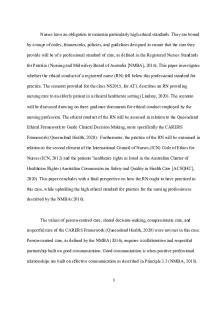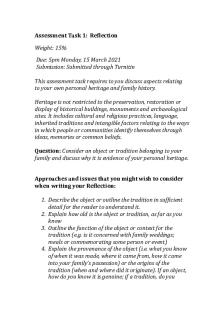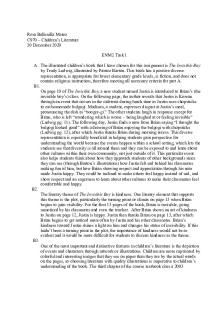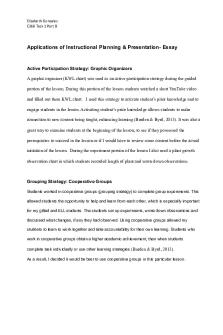NS2015 Assessment Task 1 PDF

| Title | NS2015 Assessment Task 1 |
|---|---|
| Course | Law and Ethics for Nursing and Midwifery |
| Institution | James Cook University |
| Pages | 7 |
| File Size | 118.9 KB |
| File Type | |
| Total Downloads | 19 |
| Total Views | 166 |
Summary
Assessment Task 1 for NS2015, grade Credit...
Description
Nurses have an obligation to maintain particularly high ethical standards. They are bound by a range of codes, frameworks, policies, and guidelines designed to ensure that the care they provide will be of a professional standard of care, as defined in the Registered Nurses Standards for Practice (Nursing and Midwifery Board of Australia [NMBA], 2016). This paper investigates whether the ethical conduct of a registered nurse (RN) fell below this professional standard for practice. The scenario provided for the class NS2015, for AT1, describes an RN providing nursing care to an elderly patient in a clinical healthcare setting (Lindsay, 2020). The scenario will be discussed drawing on three guidance documents for ethical conduct employed by the nursing profession. The ethical conduct of the RN will be assessed in relation to the Queensland Ethical Framework to Guide Clinical Decision Making, more specifically the CARERS Framework (Queensland Health, 2020). Furthermore, the practice of the RN will be examined in relation to the second element of the International Council of Nurses (ICN) Code of Ethics for Nurses (ICN, 2012) and the patients’ healthcare rights as listed in the Australian Charter of Healthcare Rights (Australian Commission on Safety and Quality in Health Care [ACSQHC], 2020). This paper concludes with a final perspective on how the RN ought to have practiced in this case, while upholding the high ethical standard for practice for the nursing profession as described by the NMBA (2016).
The values of person-centred care, shared decision-making, compassionate care, and respectful care of the CARERS Framework (Queensland Health, 2020) were not met in this case. Person-centred care, as defined by the NMBA (2016), requires a collaborative and respectful partnership built on good communication. Good communication is when positive professional relationships are built on effective communication as described in Principle 3.3 (NMBA, 2018).
1
The RN did not provide information to the patient about her care in a respectful, kind, and compassionate manner protecting the patient’s dignity, when the nurse loudly stated the patient had wet the bed and must come for a shower. The RN, therefore, did not meet Standard 2.2 of the Registered Nurses Standards for Practice (NMBA, 2016). Subsequently, when the RN proceeded to grab the patient by the arm in an attempt to swing her legs out of the bed, the registered nurse neglected to give the patient adequate time to ask questions, make decisions, and possibly refuse care or treatment as they are bound to do by Principle 2.3b of the Code of Conduct (NMBA, 2018). The RN did not gain consent when proceeding with the actions, and, consequently, did not apply the Decision-Making Framework for Nurses and Midwives (NMBA, 2020), which states, in Part 1: consent must be gained from the person receiving care. RNs are obligated to adhere to this framework, according to Standard 1.4, in regards decision making (NMBA, 2016). In addition, the CARERS Framework (Queensland Health, 2020) is dedicated to minimise harm. This was compromised when the RN’s actions caused pain to the patient’s ankle and when the patient was abused. The impact on the ankle was a result of the tort of battery, based on common law principles as defined by Staunton and Chiarella (2013) since the RN proceeded without consent, but there was not likely an intent to harm. In accordance with Standard 1.4 (NMBA, 2016), registered nurses must comply with common law, and therefore, the professional standard has not been met. When the RN sharply slapped the patient on the arm it was a matter of abuse. The United Nation’s Principles, adopted by resolution of the United Nation’s General Assembly in 1991, state that all persons have the right to protection from physical or other abuse and degrading treatment, as described by Staunton and Chiarella (2013). The fundamental human right of being safeguarded from physical abuse has been violated, while safe, quality practice,
2
has not been applied by the RN, and is therefore not in accordance with Standard 6 of the Registered Nurses Standards for Practice (NMBA, 2016).
Drawing upon the second principal element of the ICN Code of Ethics for Nurses (2012), being nurses and practice, nurses conduct must be of a standard which reflects well on the profession and enhance its image (ICN, 2012). Physical abuse is a criminal offence and could, as described by Staunton and Chiarella (2013), result in a professional disciplinary matter as well as a criminal matter. Engaging in criminal activity is breaking professional ethics and will reflect poorly on the nursing profession, breaching Element 2 (ICN, 2012). Furthermore, nurses carry personal responsibility and accountability for their practice (ICN, 2012) and, as clarified by Battie & Steelman (2014), this is key for trust, morale, and performance in the nursing profession. Oyetunde & Brown (2012) emphasize the importance of accountability by proclaiming it to be the hallmark of the nursing profession. The RN did not take accountability, as defined by the NMBA (2016), for their actions when the patient was threatened, by stating, “you’ll be sorry”. By failing to meet Standard 3.4 (NMBA, 2016) concerning accepting accountability for actions and behaviours, and physically abusing the patient, the RN breached the ICN Code of Ethics for Nurses (ICN, 2012) and did not meet the expected standard of care.
The patient rights of safety, respect, partnership, information, privacy, and the right to give feedback, as set out in the Australian Charter of Healthcare Rights (ACSQHC, 2020), have been violated by the RN. When the nurse loudly announced that the patient wet the bed, the patient’s right to privacy and respect were in dispute since this information was not kept confidential, she was not treated with dignity, and her personal privacy was not respected. The patient did not receive clear information about her condition or a treatment plan, since the only 3
information she received was that she wet the bed and must be showered. Consequently, when the RN proceeded to get the patient out of bed, the RN withheld the patient the option of asking questions, and to be involved in an open and honest communication in regards the patient's decision making. These actions resulted in violating the patient’s right to information and partnership as described in the Australian Charter of Healthcare Rights (ACSQHC, 2020). When the patient was physically abused by the RN, the patient did not receive safe and high-quality health care. The nurse’s conduct did not meet national standards, as mentioned previously, and the RN did not create an environment where the patient would have felt safe. Furthermore, the patient’s right to give feedback or voice a complaint was violated when the nurse stormed off with the aforementioned threatening statement directed towards the patient.
This paper has found the RN’s practice to be non-compliant with the accepted professional standard for nurses since the RN did not adhere to Standard 6.5 (NMBA, 2016), which states the RN practices in accordance with relevant nursing and health guidelines, standards, regulations, and legislation. National Safety and Quality Health Service Standards (NSQHS Standards) have been created to protect the public from harm (ACSQHC, 2017). Action 5.34 of the NSQHS Standards (ACSQHC, 2017) states that health service organisations have processes to support carers to identify patients at risk of becoming aggressive or violent and on how to implement deescalation strategies. In this scenario, where it was mentioned that the patient had a deterioration in her mental status, and was assessed as quite confused, she would have identified as a patient at risk of becoming aggressive or violent as described by the ACSQHC (2017). The RN should have, in accordance with Standard 4 and 5 (NMBA, 2016), regarding comprehensive assessment and developing a plan, investigated the procedures and de-escalation strategies the hospital ought
4
to have. In the care plan, the RN should have had a process in place to support collaboration with the patient to safely manage aggression, and minimise harm to the patient (ACSQHC, 2017). Effective communication and a person-centred approach are imperative to accomplish a collaborative and safe environment. The findings from Braaten & Malmedal’s research (2017) support that, when nurses are aware of the significance of good communication, and apply a person-centred approach, elderly abuse can be prevented. The RN in the scenario should have applied a person-centred approach (NMBA, 2018) and established a collaborative and respectful partnership built on mutual trust and understanding through good communication (NMBA, 2016) and informed consent as explained in Principle 2.3 (NMBA, 2018). Consequently, comprehensive safe, quality practice should have been provided in accordance with Standard 6.1 (NMBA, 2016). Changes to the practice, if necessary, should have been guided by the needs of, and feedback from, the patient in accordance with Principle 7 (NMBA, 2020). Furthermore, the RN should have carried personal responsibility and accountability for their nursing practice (ICN, 2012) as Gamble & Ion (2017) identified RNs awareness of their accountability as one of the steps to minimise risk for individual and systematic care failure for elderly patients. If the RN had practiced in the described manner, the maleficence, as described by Johnstone (2016), would have not occurred. The relevant nursing and health guidelines, standards, regulations, and legislation would have been adhered to by the RN and the care provided would have been in accordance with the expected standard for the profession.
Word count: 1537
5
References
Australian Commission on Safety and Quality in Health Care. (2017). National safety and quality health service standards. https://www.safetyandquality.gov.au/sites/default/files/2019-04/National-Safety-andQuality-Health-Service-Standards-second-edition.pdf Australian Commission on Safety and Quality in Health Care. (2020). My healthcare rights. https://www.safetyandquality.gov.au/sites/default/files/2019-06/Charter%20of %20Healthcare%20Rights%20A4%20poster%20ACCESSIBLE%20pdf.pdf Battie, R. & Steelman, V.M. (2014). Accountability in nursing practice: Why it is important for patient safety. AORN Journal, 100(5),537-541. http://doi.org/10.1016/j.aorn.2014.08.008 Braaten, K.L. & Malmedal, W. (2017). Preventing physical abuse of nursing home residents: As seen from the nursing staff’s perspective. Nursing open, 4(4), 274. https://doi.org/10.1002/nop2.98 Gamble, C. & Ion, R. (2017). Poor care and the professional duty of the registered nurse. Nursing older people, 29(4), 20-24. https://doi.org/10.7748/nop.2017.e908 International Council of Nurses. (2012). The ICN code of ethics for nurses. https://www.icn.ch/sites/default/files/inline-files/2012_ICN_Codeofethicsfornurses_ %20eng.pdf Johnstone, M.-J. (2016). Bioethics: A nursing perspective (6th ed.). Elsevier. Lindsay, D. (2020). NS2015: Law and ethics for nursing and midwifery; Subject outline. Learn JCU. https://learn.jcu.edu.au/
6
Nursing and Midwifery Board of Australia. (2016). Registered nurses standards for practice. https://www.nursingmidwiferyboard.gov.au/Codes-Guidelines-Statements/Professionalstandards.aspx Nursing and Midwifery Board of Australia. (2018). Code of conduct for nurses. https://www.nursingmidwiferyboard.gov.au/Codes-Guidelines-Statements/Professionalstandards.aspx Nursing and Midwifery Board of Australia. (2020). Decision-making framework for nursing and midwifery. https://www.nursingmidwiferyboard.gov.au/Codes-GuidelinesStatements/Frameworks.aspx Oyetunde, M.O. & Brown, V.B. (2012). Professional accountability: Implications for primary healthcare nursing practice. JONA’S Healthcare law, ethics, and regulation, 14(4), 109114. https://doi.org/10.1097/jhl.0b013e318276308f Queensland Health. (2020). Queensland ethical framework to guide clinical decision making in the COVID-19 pandemic. Queensland Government. https://community.amaq.com.au/HigherLogic/System/DownloadDocumentFile.ashx? DocumentFileKey=77ad2a98-5496-4af4-9700-47609b40ab3a&forceDialog=0 Staunton, P.J. & Chiarella M. (2013). Law for nurses and midwives (7th ed.). Elsevier.
7...
Similar Free PDFs

NS2015 Assessment Task 1
- 7 Pages

BSBPMG522 Assessment Task 1
- 9 Pages

Assessment TASK 1 – Scenario
- 5 Pages

Assessment Task 1
- 2 Pages

Reflection Assessment Task 1
- 4 Pages

Assessment Task
- 3 Pages

Bsbcrt 412 - Assessment Task 1
- 5 Pages

Bsbcmm 511 - Assessment Task 1
- 14 Pages

Assessment Task 3
- 1 Pages

Remedies - Assessment Task
- 5 Pages
Popular Institutions
- Tinajero National High School - Annex
- Politeknik Caltex Riau
- Yokohama City University
- SGT University
- University of Al-Qadisiyah
- Divine Word College of Vigan
- Techniek College Rotterdam
- Universidade de Santiago
- Universiti Teknologi MARA Cawangan Johor Kampus Pasir Gudang
- Poltekkes Kemenkes Yogyakarta
- Baguio City National High School
- Colegio san marcos
- preparatoria uno
- Centro de Bachillerato Tecnológico Industrial y de Servicios No. 107
- Dalian Maritime University
- Quang Trung Secondary School
- Colegio Tecnológico en Informática
- Corporación Regional de Educación Superior
- Grupo CEDVA
- Dar Al Uloom University
- Centro de Estudios Preuniversitarios de la Universidad Nacional de Ingeniería
- 上智大学
- Aakash International School, Nuna Majara
- San Felipe Neri Catholic School
- Kang Chiao International School - New Taipei City
- Misamis Occidental National High School
- Institución Educativa Escuela Normal Juan Ladrilleros
- Kolehiyo ng Pantukan
- Batanes State College
- Instituto Continental
- Sekolah Menengah Kejuruan Kesehatan Kaltara (Tarakan)
- Colegio de La Inmaculada Concepcion - Cebu





